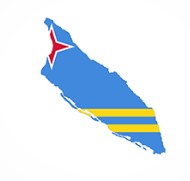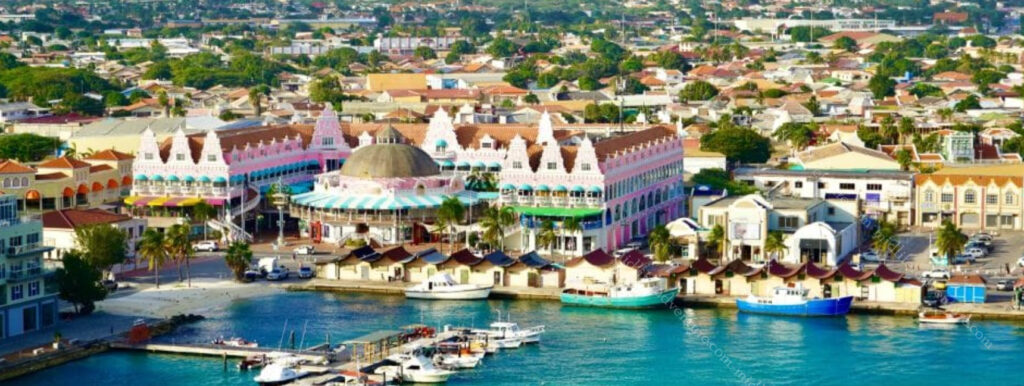

Aruba is officially known as the Country of Aruba but is captured within the Kingdom of the Netherlands. It sits in the south Caribbean about 29 km north of Venezuela and 80 km northwest of Curaçao.
The first people to settle on Aruba were the Arawak Caquetío, who arrived around 850 to 1000 AD. The Spanish arrived in the 16th century enslaving the Caquetío for use in their other colonies. But the Dutch seized Aruba during the Thirty Years War.
Unlike the Spanish the Dutch had a relatively hands-off approach to colonialism and used the island to raise livestock, a job they delegated to the Caquetío already living there. This allowed the native Arawak culture to survive through the colonial era and leading to a hybrid culture with Spanish, Dutch, and Arawak characteristics.



The first thing that really needs to be known is that there is no ‘bad’ time to visit Aruba as it sits outside of the hurricane belt and is protected from the major storms. The island itself is relatively flat with the highest point on the island being Jamanota Hill with a massive elevation of 189 meters. The Southside of the island is typically for swimming and the North side of the island is for scenic views.

Our entry was into the capital city of Oranjestad named after ‘Huis van Oranje’ (Orange House), the name of the Dutch Royal Family in 1824 during the Dutch colonisation.
The town features some Dutch Colonial architecture but has mostly been Americanised with the usual suspect chain junk food stores ubiquitous. Oranjestad is most famous for its historical landmarks, which have been carefully restored to give visitors a sense of what the city looked like during its colonial-era past.
Our usual plan is to check out the town and get all of our tourist photos out of the way before hitting the other things (the problem of being a slave to this blog). But this time we did it a bit differently. Hooking up with Patrick and Anna (from dinner and Cartagena fame) we hopped in a cab and headed straight to the beach.




Now as Australians we usually are greatly disappointed by overseas beaches as they seldom even come close to what we are used to. But Aruba is an exception. These beaches have the fine white sand, long stretches and even have some of the beach umbrella amenities that we generally don’t have. Yes they are for hire or are part of a resort, but there is so much beach that it really doesn’t matter as there is plenty of room for everyone.





Along the beaches are a steady stream of resorts and hotels that (typically) offer all-inclusive drink packages. This meant for us blow-ins buying a beer in the heat was not as easy as you would have thought. But being the dedicated and persistent souls that we are, we were able to find a venue that could sate our needs.





Cold local beers and cocktails, in a nice venue, right on the sand were not entirely terrible. As the timing would have it, after our first round the 5pm bell rang for happy hour making every subsequent drink two-for-one. So our cocktails and beers continued as we watched a relatively impressive sunset over the Aruban sand and sea.







Fort Zoutman is the oldest building on the island, originally built in 1798 by African slaves. It is regarded by UNESCO as a ‘Place of Memory of the Slave Trade Route in the Latin Caribbean’. The Willem III Tower was added in 1868 and the whole place was restored and re-opened in 1983 as the Historical Museum of Aruba.

Having taxied to the beach we had wandered our way back to town and the ship (admittedly pausing briefly). At this point, we did the tourist shopping run and looked around the area. As we knew we would be coming back (in about 2 weeks) we didn’t exactly bust a boiler to see everything, leaving some things for our next visit.
Aruba Part II
Having only been in Aruba a few weeks ago this trip was just a pop-in for us. Last time we got off in Oranjestad and turned left to head up to Eagle Beach. So this time we decided to turn right. This saw us wandering along the shoreline, through the city centre and checking out the statues, shops and stores.





We walked for a fair way coming across very little of note but did find a city with a generally nice feel. There was no aggression or angst, just a really nice place to kick back and have a beachside holiday.







Clearly, going left and taking in the beaches is the option. But from everything that have experienced in Aruba it confirms that it is just a great spot to visit.